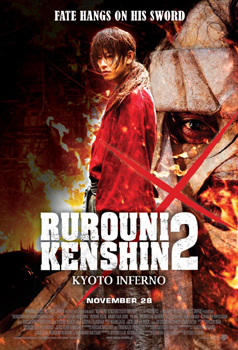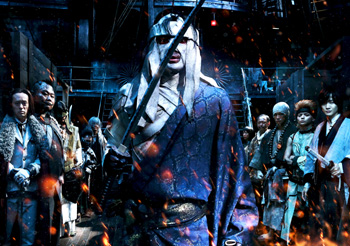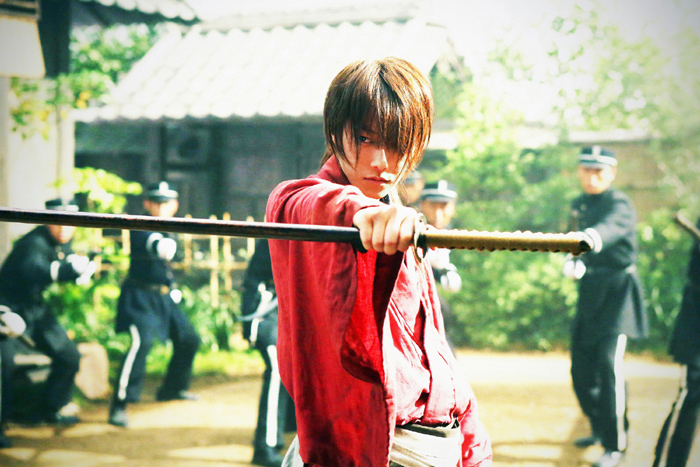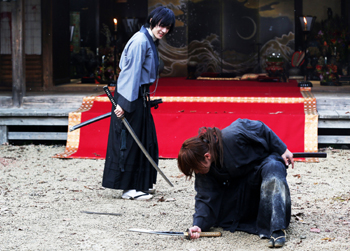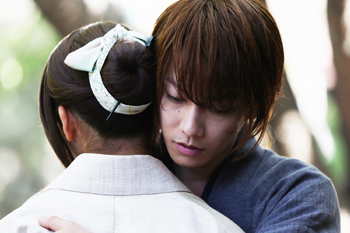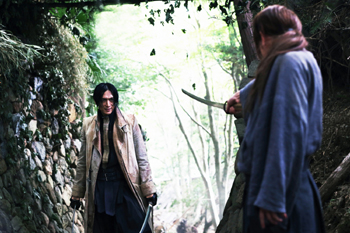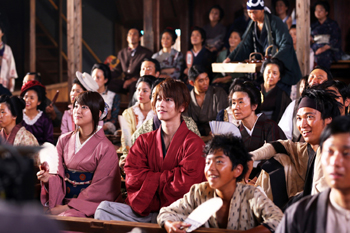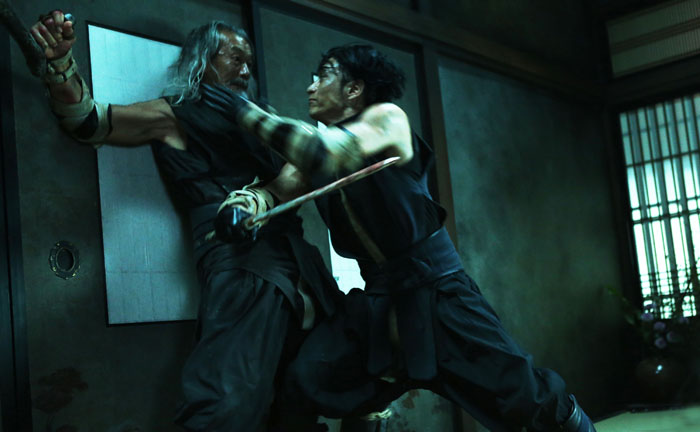Live Action Manga Adaptation Opens Friday, November 28th Source: Warner Bros. Pictures UK, Maven Publicity Official Site: kuroshitsuji-movie.jp (Japan) Special Thanks to Louise Rivers
The brand-new epic action sequel RUROUNI KENSHIN 2: KYOTO INFERNO (????????????, Rurouni Kenshin Kyoto Taika Hen, 2014) will be released in the United Kingdom this week by Warner Bros. UK. SYNOPSIS The epic live-action sequel fans have been waiting for! Kenshin Himura (Takeru Satoh) is a legendary swordsman, a hero in the wars preceding the turbulent fall of Japan’s Shogunate in the 19th century. Once feared as ‘Battosai the Killer’, with the arrival of the new Japanese age and nursing the pain of losing many of his companions he is now a lone wanderer, roaming the land seeking to be of service to those in need. Fate however, had taken hold of Kenshin’s future and was now guiding him toward a new destiny. Without warning he is summoned by Home Minister Toshimichi Okubo (Kazufumi Miyazawa), and is informed that Makoto Shishio (Tatsuya Fujiwara), his successor in the service of the new government, believed to be dead, is in fact both alive and plotting in Kyoto. Driven by a burning revenge Shishio commands a private army of bloodthirsty mercenaries and is planning to overthrow the government and will stop at nothing to take control. In that moment it becomes clear why he has been summoned; Kenshin is the only man alive who can find Shishio... and stop him. Kenshin must summon every warrior skill he possesses to fight dangerous and brutal enemies along fate’s journey; leading to the ultimate bloody confrontation... blade on blade, soul against soul. ABOUT THE FILM FRANCHISE With the release of RUROUNI KENSHIN (??????) on August 25th, 2012, Japanese film entered a new era. A commercial film combining unparalleled speed and overwhelming action in a moving human drama, it was a bombshell creating what can be described as riotous enthusiasm. This was the first motion picture inspired by Kenshin the Wanderer: The Romance of the Meiji Swordsman (Shueisha Jump Comics), the monumental manga comic by Nobuhiro Watsuki that has sold more than 5.8 million copies and been translated into more than 20 languages. The filmmakers faced a serious challenge in meeting the high expectations of the manga fans, a challenge they succeeded beyond anyone’s expectations in meeting as the film was met with rapture throughout Japan, quickly taking in more than 3 billion yen at the box office. Word-of-mouth spread quickly overseas, and RUROUNI KENSHIN has now been shown at 31 festivals and received distribution in 64 territories.
The production team was aware from the start that the Rurouni Kenshin story would not be complete without a film version of the Kyoto Arc, the highest-rated and best-loved segment that serves as a climax to the manga series. Coincidentally, the resolution and determination with which the main character Kenshin survives through a turbulent age serve as a guidepost pointing toward the future for those of us alive now. RUROUNI KENSHIN 2: KYOTO INFERNO; With a production budget of 3 billion yen, six months in the filming, 5,000 extras, and locations all over Japan from Yamagata in the north to Kumamoto in the south, this is a project that pushes back the boundaries of Japanese film: two films that break new ground, and whose successive release will set off shock waves everywhere. Rising to the challenge of playing Kenshin, who leaves those he loves to devote himself single-mindedly to the cause of peace, is Takeru Satoh, whose performance in a breathtakingly revolutionary style of intense action unlike anything to be found in Hollywood or continental Asia will leave no viewer unmoved. Also returning from the first KENSHIN movie are Emi Takei as Kaoru Kamiya, Munetaka Aoki as Sanosuke Sagara, Yu Aoi as Megumi Takani, and Yosuke Eguchi as Hajime Saito. A wealth of famous faces joins the cast this time out. Appearing with Takeru Satoh for the first time, as the crazed Makoto Shishio, is the popular character actor Tatsuya Fujiwara. Performing in hot, heavy, stifling bandages that even make it hard for him to hear, he becomes the personification of pure evil with an overpowering and epochal performance. As Sojiro Seta, the skilled leader of Shishio’s ‘Ten Swords’ group of henchmen, is Ryunosuke Kamiki, who breaks new ground in with the mesmerizing pace of the speediest swordfights in the series. Another opponent Kenshin faces is Aoshi Shinomori, a former ‘Hidden Watcher’ ninja in the service of the Shogun, played here by Yusuke Iseya. Outstanding in his action sequences, his performance also embodies all the grief of a man condemned to live in a time for which he was not born. As the ninja ‘Elder’ who breaks with Aoshi and allies himself with Kenshin is Min Tanaka, while Tao Tsuchiya plays Misao Makimachi, who fights beside Kenshin but still loves Aoshi. Returning as director is Keishi Otomo, highly respected around the world for such works as RYOMADEN (???, 2010) and PLATINUM DATA (???????, Puratina Deta, 2013). Gathering his production staff from the first KENSHIN movie, he combines painstaking attention to detail with spectacle on a grand scale in his single-minded pursuit of a world-within-film like no other. The theme song is by the internationally popular band ONE OK ROCK, who has written two individual songs for both films.
KYOTO INFERNO’S SUCCESS The first part of the final installment of the RUROUNI KENSHIN live-action film series, RUROUNI KENSHIN 2: KYOTO INFERNO earned a staggering 4,013,551,800 yen (US $38.5 million) with 3,108,685 ticket sales in just 28 days since its opening in Japan on August 1 2014. KYOTO INFERNO surpassed the box office record of the first live-action film dominating this season of summer blockbusters and becoming the biggest Japanese live-action movie of 2014! The time has now come: in answer to calls from around the world demanding ‘more Kenshin’, Warner Bros. present the epic action sequel RUROUNI KENSHIN 2: KYOTO INFERNO coming to UK cinemas on Friday 28th November 2014. ORIGINAL STORY Kenshin the Wanderer: the Romance of a Meiji Swordsman is a hit manga comic by Nobuhiro Watsuki that ran from 1994 to 1999 in Shueisha Publishing’s Weekly Shonen Jump magazine. A TV animation ran on the Fuji network from 1996 to 1998, and together with its hit theme song generated huge fan interest. An animated feature was released in 1997. Rurouni Kenshin, The Cinema Version was serialized in Jump Square together with release of the live-action feature RUROUNI KENSHIN in 2012, and published in book form as Rurouni Kenshin Special. A series of Makoto Shishio spin-off prequel/sequel stories began in Jump Square to accompany the release of KYOTO INFERNO in August 2014. NOBUHIRO WATSUKI Born in 1970 in Tokyo, as a high-school student he won the Tezuka Award for Teacher Pon. Besides Kenshin the Wanderer: the Romance of a Meiji Swordsman, his manga hits also include Gun Blaze West and Busou Renkin. His Embalming is being serialized in Jump Square magazine.
Comment “Because there was too much in KYOTO INFERNO to fit into one movie, I was ready for huge cuts and big changes, so I’d made up my mind right from the start, from the first movie, to respect the opinion of director Otomo. But the script has got everything into it very nicely. Mr Satoh has settled back into the role, and brings out that calm and gentle side of Kenshin even more. The action has jumped right over the first movie, and they’ve made it really amazing." "Because Shishio’s face is covered in bandages, I thought it would require an actor who could bring a very strong emotion to his performance. I met Mr Fujiwara just before filming started, and he’d already gotten into the role so he was kind of frightening, and I went ‘He’s the guy!’ Mr Iseya’s perfect for his role, too, and he’s great in it. ‘Purgatory’ had to really jump out at you in this film, but in the original manga there was nothing for them to draw on. Unfortunately it was just an exit point with no real action. I’m really happy they adopted it. But the movie is very close to the original, so I hope that audiences will feel very close to it.” DIRECTOR/WRITER: KEISHI OTOMO Born in 1966 in Iwate Prefecture, he joined NHK in 1990 after graduating from the Law Faculty of Keio University. In 1997 he went to the U.S., and spent two years studying scriptwriting and directing in Los Angeles. On his return, he directed a series of NHK TV programs, including the CHURUSAN (?????, 2001-2004) series, the Saturday night drama THE VULTURE (????, Hagetaka, 2007), the drama special JIRO SHIRASU: MAN OF HONOR (??????????? ???????????????, Makkaasaa o Shikatta Otoko ~Shirasujiroo Sengo Fukkoo e no Choosen~, 2009), and the Sunday night historical drama series RYOMADEN. He also directed the feature-film version of THE VULTURE (????, Hagetaka, 2009), and is the recipient of many awards, both in Japan and abroad, including a Prix Italia, a Hoso Bunka Foundation Award, a Galaxy Award, an Arts Festival Award for Excellence, an International Drama Festival in Tokyo Award for Best Drama, an Élan d’Or Award, the Nikkei Hitmaker of the Year prize, and a Director’s Award from the Hoso Bunka Foundation. Leaving NHK in 2011, he established himself as an independent director with the smash hit RUROUNI KENSHIN, following this with PLATINUM DATA in 2013. NHK Publishing released his book How to Fight Creatively in 2013. CAST ? Kenshin Himura: TAKERU SATOH Born March 21st, 1989 in Saitama Prefecture, his first starring role came in MASKED RIDER DEN-O (TV Asahi, 07). He came to wide attention in the ROOKIES SP (??????????, Ruukiizusupesharu, 2008) TBS-TV series, and won a Television Drama Academy Best Supporting Actor award for Fuji TV`s MEI-CHAN’S BUTLER (????????, Mei-chan no Shitsuji, 2009). The NHK Sunday night drama RYOMADEN marked his first period role, and the same year he took a starring role in the Q.10 (2010) drama serial for NTV, going on to win the All Nippon Producers Association Élan d’Or Newcomer of the Year Award in 2011. In 2012 he extended his activities to the live stage, playing Romeo in a production of "Romeo and Juliet". Other television work includes TBS` TONBI (??? , 2013) and Fuji TV`s BITTER BLOOD (????????, Bita Buraddo, 2014). Following his starring role in the first RUROUNI KENSHIN film, he has appeared in REAL (?????????????, Riaru Kanzen Naru Kubinagaryu no Hi, 2013) and THE LIAR AND HIS LOVER (?????????????, Kanojo wa Uso o Aishisugiteru, 2013). Earlier film roles include GOEMON (????, 2009), ROOKIES THE MOVIE: GRADUATION (R??????????, Rookies -Sotsugyoo-, 2009), TRICK THE MOVIE: PSYCHIC BATTLE ROYALE (???TRICK????????????, Gekijooban Trick: Reinosha Batoruroiyaru, 2010), and BECK (???, Bekku, 2010). ? Kaoru Kamiya: EMI TAKEI Born on Christmas Day of 1993 in Aichi Prefecture, she was the Model and Multimedia winner in the 2006 Japan Bishojo Contest, making her debut as a model in the February 2007 edition of Seventeen magazine. Her first major television role came in the 2009 Fuji TV serial OTOMEN: NATSU (???? ), and she took a main supporting role in Fuji`s YOU TAUGHT ME ALL THE PRECIOUS THINGS (?????????????????, Taisetsu na Koto wa Subete Kimi ga Oshiete Kureta, 2011) before starring in the TV Asahi serial ASUKO MARCH! (???????!, Asuko Machi!: Asuka Kogyo Koko Monogatari, 2011). With the success of the first RUROUNI KENSHIN movie in 2012, she has also starred in FOR LOVE`S SAKE (???, Ai to Makoto, 2012) and LOVE FOR BEGINNERS (??????????, Kyo, Koi wo Hajimemasu, 2012). Television work since then has included the NHK Sunday night period drama TAIRA NO KIYOMORI (???, 2012) and SENRYOKUGAI SOSAKAN (??????, 2014). The motion picture CLOVER (?????, Kuroba) was released in November 2014. ? Sanosuke Sagara: MUNETAKA AOKI Born in 1980 in Osaka, he made his feature debut with BATTLE ROYALE II (????????? II????????????, Batoru Rrowaiaru II: Chinkonka, 2003), going on to star in the NHK series TSUNAGARETA ASU (??????) in 2006, the 2007 NHK morning drama series CHIRITOTECHIN (??????, 2007-2008), and the NHK Sunday night historical drama series RYOMADEN and TAIRA NO KIYOMORI. His films include the UMIZARU series (2004, 2006, 2010), OPPAI VOLLEYBALL (???????, Oppai Bare, 2009), TIME TRAVELLER: THE GIRL WHO LEAPT THROUGH TIME (???????, Toki o Kakeru Shojo, 2010), HARA-KIRI: DEATH OF A SAMURAI (??, Ichimei, 2011), and the first in the RUROUNI KENSHIN series. Since then his work has included FLY WITH THE GOLD (????????, Ogon wo Daite Tobe, 2012), the NHK TV series HATSUKOI (???, 2012), PRINCESS SAKURA: FORBIDDEN PLEASURES (??, Sakura Hime, 2013), NHK`s MEATO ZENZI (????, 2013), IKITAI TASUKETAI (???? ?????, 2014) and MUSASHI MIYAMOTO SP (????, 2014). His most recent movies are THE WORLD OF KANAKO (??, Kawaki, 2014) and A SAMURAI CHRONICLE (???, Higurashi no Ki, 2014). ? Megumi Takani: YU AOI Born August 17th, 1985 in Fukuoka Prefecture, she made her stage debut in 1999 with the musical "Annie", her film debut in 2001 with ALL ABOUT LILY CHOU-CHOU (????????????, Riri Shushu no Subete), and went on to perform as a drama series regular in TBS` KOKO KYOSHI series (????, 2003)?Other films include HANA AND ALICE (?????, Hana to Arisu, 2004), YAMATO (??????, Otoko-tachi no Yamato, 2005), HONEY AND CLOVER (??????????, Hachimitsu to Clover, 2006), ABOUT HER BROTHER (????, Ototo, 2010), the NHK costume-drama serial RYOMADEN, VAMPIRE (??????, Vanpaia, 2012), TOKYO FAMILY (????, Tokyo Kazoku, 2013), and CLIMBING TO SPRING (??????, Haru o seotte, 2014). Her well-received turn in the first RUROUNI KENSHIN broke new ground for her as a performer, but she is well-established as one of Japan’s leading young actresses, with a Blue Ribbon Best Actress Award for HONEY AND CLOVER, a Best Supporting Actress Award of the Japanese Academy for HULA GIRLS (?????, Furagaaru, 2006), and an Art Encouragement Prize from the Ministry of Education for MILLION YEN GIRL (???????, Hyakuman-en to Nigamushi Onna, 2008). ? Shinomori Aoshi: YUSUKE ISEYA Born May 29th, 1976 in Tokyo, he made his debut in AFTER LIFE ( ????????, Wandafuru Raifu, 1999), and subsequently appeared in such well-known films as CASSHERN (??????, Kyashaan, 2004), MEMORIES OF MATSUKO (Kiraware Matsuko no Issho, 2006), and 13 ASSASSINS (??????, Jusan-nin no Shikaku, 2010). His many awards include a Best Supporting Actor Blue Ribbon Award for his role as Toru Rikiishi in TOMORROW`S JOE (???????, Ashita no Joe, 2011). A character actor highly praised for his on-screen presence, he has appeared since then in a wide range of roles, including the NHK costume-drama series RYOMADEN, KAIJI 2 (???2 ???????, Kaiji 2: Jinsei Dakkai Gemu, 2011), DREAMS FOR SALE (??????, Yume Uru Futari, 2012), THE KIYOSU CONFERENCE (????, Kiyosu Kaigi, 2013), and ASK THIS OF RIKYU (???????, Rikyu ni Tazuneyo, 2013). He is also the director of KAKUTO (2003) and FISH ON LAND (2012). He appears in the Japan/South Korea co-production THE TENOR LIRICO SPINTO (? ??-??? ???, Deo Teneo - Lilico Sipinto, 2014), and in JOKER GAME ( ?????????, Joka Gemu) and SHINJUKU SWAN (????? ?????????????, Shinjuku Swan Kabukicho Skauto Sabaibaru), both set for 2015 release. Q&A WITH KEISHI OTOMO --While this is a kind of action movie, it also appeals as a human drama. To put it the other way round, there’s an interior side to even the swordfights. The combination of action with character portrayals fleshes out the bones of the story, but I still feel that there is a powerful simplicity to the form of the work itself.
For example, there’s a big Sanosuke episode in the original manga, but we didn’t have time to put that into the film. So how do we give Sanosuke that drama? We do it simply: Kenshin leaves him in Tokyo. ‘That bastard’s gone and left me behind. What’s up with that? Why is he treating me like a stranger?’ And that drama of a buddy following Kenshin converges. It’s the same with Kaoru. Kenshin can’t get her mixed up in this, so he pulls away from her. And as he does so, it turns into the story of Kaoru drawing nearer to him. Little by little, the distance between the two of them shifts. And then on the other side there are Aoshi and Shishio. Each in his own way is fixated on the Shogunate, and they’re both after Kenshin. So in effect, all four of them are chasing after Kenshin. Kenshin’s always at the center. With the fire in Kyoto, everyone gets one foot into the realm-of-blood scenario that Shishio has prepared for them. Kenshin, who has extracted himself from that realm, and Kaoru, who has never been in it, are involved in the same fight, and seem to be drawing together, but then they gradually pull apart... I think that’s the structure we ended up with. But a script is kind of like a mathematical formula. Into this world of mathematical logic are placed actors, actors -- the kind of actors I like, anyway -- who won’t be persuaded, who refuse to be persuaded, unless it has a sense of body, unless there’s some skin in the game. That’s because we want to transform what was a very successful original manga story. Things that don’t happen on the page -- people sweat, they sweat when they move, they get out of breath, their hair gets all messed up -- what happens as a result of that? How do we get that kind of atmosphere into the movies? We give it shape, not by imagining the characters in our heads, but by understanding the characters as they do battle. What we’re trying to do is make a movie out of flesh and blood. The most important thing is that all of the characters express themselves through the battles they find themselves in. --The story doesn’t seem episodic; everything seems to surge on that great stage of the Kyoto fire. After the first movie, we knew we could go ‘this far’, and it was very much in our minds at the script-writing stage for these films that the action and the drama would emerge with the same intensity. And that’s hard to do. When you’re shooting action, you’re basically shooting motion. When you’re shooting drama, you’re basically shooting emotion. But in motion there is emotion. You have to find it, and join motion and emotion into one, and film it with the sense of the feeling and the expression uppermost in mind. That’s a pretty high hurdle to get over. With the first movie, our motto was ‘do the impossible’; this time it was ‘overdo the impossible’ (Laughs). Anyway, I want to see the real thing. OK, so what is the real thing? It means that everything on the screen is great, and you push that as far as it will go. Everybody, the entire cast and staff, kept that feeling all the way through. That energy, I think, is what really surges. --And Takeru Satoh really pulls everything together. There are roles that mark a turning point in an actor’s career. The encounter of Takeru Satoh and Kenshin was an encounter of very rare timing. A miracle among miracles, I think.
He’d played an assassin in RYOMADEN, and the extension of that line intersected with my going independent. For Takeru, it was a once-in-a-lifetime role. A lot of things had to be perfectly timed for that to happen. I think that’s always very important in things like stories or movies. And strangely, that background always comes out somehow in the picture. Takeru Satoh is of a generation that doesn’t really know period-piece movies. As a guy like him plays Kenshin, through the Kenshin he portrays, you can find young people’s aesthetic idea of what is a ‘cool guy’. And by doing that, ‘cool’ as they define it combines with our generation’s definition of the samurai as ‘cool’. That dynamism, that interest, creates an approach to universality whose potential you can really feel. When Akira Kurosawa was going to make SEVEN SAMURAI, he said he wanted it to be like steak with butter melted over it and eel in kabayaki sauce on top. He was absolutely not going to serve his audience just rice in hot tea. That was the sense in which he made his movie, but now even SEVEN SAMURAI strikes people brought up on computer games as long and slow. Times have changed; they don’t have the stomach for a meal like that. So how do you feed the computer games generation so they feel full? That’s what I’m trying to do with the RUROUNI KENSHIN movies. --So will THE LEGEND ENDS surge the same as KYOTO INFERNO? No, we’ve made that one a little different. I think it has to be different from both the first film and KYOTO INFERNO. THE LEGEND ENDS starts quietly. Things happen that are off the main axis. The situation evolves with Kenshin not there. How will Kenshin return to do battle with Shishio? Perhaps he has another card up his sleeve. But the theme of Kenshin’s atonement for the many people he’s killed does not change. A man who lives in atonement, and a man who does not, must inevitably do battle. That fateful battle-- somewhere there are people waiting expectantly for Kenshin and Shishio to climb into the ring together -- that ‘cannibalism’ is the structure I’m thinking of. Maybe someone is using some kind of dynamic to make the two of them fight. To that end I want to inject a little bit of ‘poison’. I want Kenshin to be falling apart. All the fighters get hurt and fall to pieces. I want that to be merciless. Why are these guys fighting? If that question doesn’t rise up within us, the theme of the killer’s atonement doesn’t emerge. People tend to think that ‘entertainment’ means stripping away the fat and the complications, but I don’t think that’s true. I don’t want to fix on turning points in the story; I want to fix on turning points in the lives of the characters. Kenshin doesn’t face Shishio as a straight-down-the-line champion of justice. He gets confused; his certainties are shaken. When you’ve finished watching THE LEGEND ENDS, what’s left? Something heavy, I hope.
ABOUT THE PRODUCTION ? Filming in Quest of the Most - A six-month shoot, 5,000 extras, more than 30 locations First the filming, which was set for five months, was extended to six. 2013 was a year of more than the usual number of typhoons, and shooting was suspended four times due to inclement weather, with a total loss of 20 days. The shooting schedule had to be arranged to fit around the commitments of a cast of highly popular actors, which meant problems in maximizing the efficient use of money and time. Amidst all these difficulties, the filmmakers were determined to make the new RUROUNI KENSHIN the greatest visual experience possible in a Japanese film. The biggest item was locations: there were more than 30 of these, scattered over ten different prefectures, from one end of the country to the other. ‘That’s how it worked out,’ says Koiwai. ‘This was not the Edo-period world of the Shoguns, nor was it modern times. Because RUROUNI KENSHIN takes place early in the Meiji Era, a time that was giving birth to a new set of values and a new landscape, we needed variety in our locations. There weren’t many places offering that particular combination of Japan and the West. And if we compromise even a little, that world of RUROUNI KENSHIN crumbles before our eyes. The sequel has to surpass the original, or to turn that around, I think we were able to do the things we could only have done because we were making the sequel to a very successful first movie.’ Visually, the world as it exists on screen in RUROUNI KENSHIN has deliberately been made bigger and wider in perspective. ‘There was no point in just remaking Part 1,’ says Koiwai. ‘Everybody from the director on through the cast and staff shared this awareness. In the good sense, we had to subvert the audience’s expectations. We had to give the audience more than they’d be expecting. That consciousness underlies every part of the movie. Basically, it was “more than before!”’
Considering how much tenacity had gone into the search for locations, no expense could be spared on the sets. The fiendish glint of Shishio’s ‘Purgatory’, and the character’s entry onto the screen, all of these had to be extravagant in scale. ‘From the aspect of story as well, it’s important that the locations shift. In a way, it’s a kind of road movie, and it can’t be taking place in the same kind of spaces all the time. We need a lot of variation. Of course all of this has to be believable as well. The original manga has inspired the imagination of a great many readers, and the movie needs to recreate this experience. I think the production staff at Warner Bros are going to be surprised by the scale and the quality of what they see on the screen.’ ? The Evolution of Action Leading to A Final Confrontation - Long Cuts Deepen Characters There are more than 800 costumes lending flavor to the visual effects, and the two new sequels have evolved significantly from the first RUROUNI KENSHIN, which itself represented a significant change from conventional period-piece movies. But the deciding factor is action. ‘Fortunately,’ says Koiwai, ‘the action sequences in Part 1 were well-received. So what do we do to improve on that? And so we’ve done a number of things to the locations and sets. Some are tighter, some are wider, some have a greater variation in heights. All of these things increase the potential for action sequences.’ The new films also incorporate wire action, but in the end, everything has to come down to one-on-one combat. Koiwai emphasizes that the process leading to this is what RUROUNI KENSHIN is all about. The risks that performers choose to take in challenging these intense action sequences are all taken to this end. ‘One thing that has not changed from the first picture is that the action is not simply there to create spectacle; it is an integral part of the performance. In the new films the action has more of a “documentary” quality to it in that the actors are doing more of their own stunts, and people who have seen the sequences say they feel an emotion similar to watching Mao Asada’s figure-skating performance in the Sochi Olympics, which is a great compliment to Takeru Satoh’s acting and the work of all the crew in the six months it took to film, and a result we never expected to reach.’ Koiwai says the length of the shoot helped the cast members to understand each other better, to become closer to each other, and to create a stronger drama. In effect, the scale of the production had a great influence on the ‘interiority’ of the characters. ‘When we first started, we never imagined it would reach this big a scale, even though thinking of it now it seems like it might have been a natural progression. Basically, it was inevitable. We had the hardware ready for the software we had created. We needed the right “container” to hold the content we had. That much we can boast about.’
CREDITS Running Time: 139 minutes Screen Size: 2.35:1 Japanese Theatrical Release: August 1, 2014 UK Theatrical Release: November 28, 2014 Cast Kenshin Himura: Takeru Satoh Kaoru Kamiya: Emi Takei Makato Shishio: Tatsuya Fujiwara Jin-e Udo: Koji Kikkawa Megumi Takani: Yu Aoi Aoshi Sinomori: Yusuke Iseya Sanosuke Sagara: Munetaka Aoki Gein: Gou Ayano Banjin Inui: Genki Sudo Yahiko Myojin: Taketo Tanaka Aritomo Yamagata: Eiji Okuda Hajime Saito: Yosuke Eguchi Kanryu Takeda: Teruyuki Kagawa Sojiro Seta: Ryunisuke Kamiki Makimachi Misao: Tao Tsuchiya Kashiwazaki Nenji: Min Tanaka Toshimichi Ookubo: Kazufumi Miyazawa Ito Hirobumi: Yukiyoshi Ozawa Sadojima Hoji: Ken’ichi Takito Sawagejo Cho: Ryosuke Miura Komagata Yum: Maryjun Takashi Staff Director: Keishi Ohtomo Executive Producer: William Ireton Original Comic: Nobuhiro Watsuki Screenplay: Keishi Ohtomo and Nobuhiro Watsuki Producer: Satoshi Fukushima Executive Producer: Hiroyoshi Koiwai Line Producer: Keizo Shukuzaki Cinematography: Takuro Ishizaka Art Director: Sou Hashimoto Editor: Tsuyoshi Imai Action Director: Kenji Tanigaki Stunt Coordinator: Takahito Ouchi Visual Effects Supervisor: Kazuyori Kosaka Music: Naoki Sato Planning and Production: Warner Bros. Pictures Japan, Studio Swan Theatrical Distribution (Japan): Warner Bros. Pictures Japan International Sales: Gaga Corporation © Watsuki Nobuhiro/ Shueisha. © 2014 "Rurouni Kenshin" Production Committee
For more information on the RUROUNI KENSHIN movies, please see the earlier coverage here on SciFi Japan:
- RUROUNI KENSHIN Press Notes
- RUROUNI KENSHIN North American Premiere at 2012 LA EigaFest
- RUROUNI KENSHIN on Australian Blu-ray and DVD
- Madman Acquires Final RUROUNI KENSHIN Films -- KYOTO INFERNO / THE LEGEND ENDS
- RUROUNI KENSHIN: KYOTO INFERNO / THE LEGEND ENDS Photo Galleries
- RUROUNI KENSHIN 2: KYOTO INFERNO Coming to UK Cinemas


